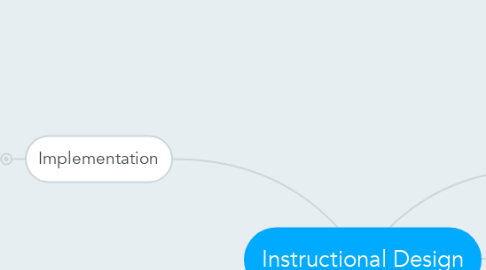
1. Implementation
1.1. Implement lesson plan
1.2. Evaluate effectiveness of lesson
1.2.1. WHERETO as either evaluation of lesson plan or model for dev
1.2.1.1. Where (objectives)
1.2.1.2. Hook
1.2.1.3. Equip and Expirience
1.2.1.4. Rethink
1.2.1.5. evaluate
1.2.1.6. tailor
1.2.1.7. organize
1.3. Gradual release of responsibility (also a Dev model)
1.3.1. I do it
1.3.2. We do it
1.3.3. You do it together
1.3.4. You do it independently
1.4. UDL
1.4.1. Representation
1.4.1.1. Perception
1.4.1.1.1. Customized information display
1.4.1.1.2. Alternatives to auditory
1.4.1.1.3. Alternatives for visual
1.4.1.2. Language
1.4.1.2.1. Clarify vocabulary and symbols
1.4.1.2.2. Clarify syntax and structure
1.4.1.2.3. Support decoding
1.4.1.2.4. Promote understanding
1.4.1.2.5. Illustrate through multiple media
1.4.1.3. Comprehension
1.4.1.3.1. activate/supply background knowledge
1.4.1.3.2. Highlight patterns and relationships
1.4.1.3.3. Guide information processing
1.4.1.3.4. Maximize transfer and generalization
1.4.2. Expression
1.4.2.1. Physical action
1.4.2.1.1. Vary response and navigation
1.4.2.1.2. Assistive Technologies
1.4.2.2. Expression and communication
1.4.2.2.1. Multiple media
1.4.2.2.2. Multiple tools for construction
1.4.2.2.3. Graduated levels of support
1.4.2.3. Executive functions
1.4.2.3.1. Goal-setting
1.4.2.3.2. Support planning
1.4.2.3.3. Manage information and resources
1.4.2.3.4. Monitor progress
1.4.3. Engagement
1.4.3.1. Recruiting engagement
1.4.3.1.1. Autonomy
1.4.3.1.2. Relevance
1.4.3.1.3. Minimize threats/distractions
1.4.3.2. Sustaining effort and persistance
1.4.3.2.1. Salience of goals
1.4.3.2.2. Optimize challenge
1.4.3.2.3. Collaboration and community
1.4.3.2.4. Mastery-oriented feedback
1.4.3.3. Self-regulations
1.4.3.3.1. Optimize motivation
1.4.3.3.2. Coping skills and strategies
1.4.3.3.3. Self-assessment
1.5. Differentiation
1.5.1. Content
1.5.2. Process
1.5.3. Product
1.5.4. Environment
1.5.5. A lot like UDL
2. Evaluation
2.1. Formative
2.1.1. Still in development: extensive comments to assist student growth
2.1.2. Drafts
2.2. Summative
2.2.1. Final, no need for extensive comments
2.2.2. Opportunities for creativity
2.3. Multiple Platforms
2.3.1. Socrative
2.3.2. Smart Response
2.3.3. Google Forms
2.3.4. Survey Monkey
2.3.5. Turning Point
2.3.6. Good old pencil and paper
2.4. Evaluation Plan
2.4.1. Objectives
2.4.2. Activities
2.4.3. Formative Assessments
2.4.4. Summative Assessments
3. Analysis
3.1. Content Analysis
3.1.1. Self-assessment of content knowledge
3.1.2. Review standards
3.1.3. Research
3.1.4. What matters?
3.1.4.1. Sequence
3.1.4.2. Organize
3.1.4.3. Weed
3.1.4.4. Synthesize
3.2. Task Analysis
3.3. Learner Analysis
3.4. Context/Resource Analysis
3.5. Work Analysis
4. Design
4.1. Objectives
4.1.1. Terminal Objectives
4.1.2. Enabling Objectives
4.1.3. ABCD Method
4.1.3.1. Audience
4.1.3.2. Behavior
4.1.3.3. Condition
4.1.3.4. Degree
4.1.4. Four Categories
4.1.4.1. Cognitive
4.1.4.2. Affective
4.1.4.3. Psychomotor
4.1.4.4. Interpersonal
4.2. Essential Questions
4.2.1. Connect two nouns with an action verb in a how/why question
4.3. Enduring Understandings
4.3.1. 2 or more concepts combine to form a relationship
4.3.2. General: no proper nouns/noun phrases
4.3.3. Stick to present tense
4.4. Review Standards
5. Development
5.1. Gagne's Nine Events
5.1.1. Gain attention
5.1.2. Inform learners of objectives
5.1.3. Stimulate recall of prior learning
5.1.4. Present the content
5.1.5. Provide Guidance
5.1.6. Elicit Performance
5.1.7. Provide Feedback
5.1.8. Assess performance
5.1.9. Enhance retention and transfer

